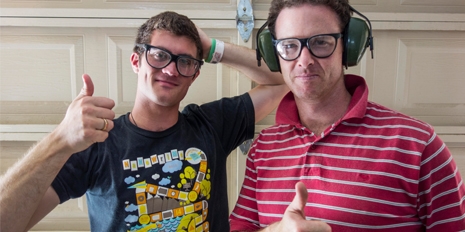
Over this past summer I have had the great pleasure of working with Locus Research on the Delloch hip protection project and, as the project comes to a close, I have been asked to share some of the experiences I have had over the past two and a half months.
The project as proposed was simple enough: investigate the current methods Delloch was using to test their hip protectors and build an alternative model that could be used for improved testing. I submitted a proposal involving a physical silicone model and a FEA computer simulation, and was fortunate enough to be granted an interview.
As I later discovered I was one of only two people granted an interview, which would normally have me clicking my heals in joy except that in a stomach churning twist the other person was a good friend of mine. Recognising the situation we had found ourselves in, we shook hands and agreed that whoever was chosen would owe the other pizza and beer. As of this date I have taken him out for pizza and I still owe him the beer.
So, at the beginning of December last year, I made my way to the Mount (making phone calls the whole way since I had failed to arrange accommodation for myself) and ultimately found my way to a cosy little caravan in a tree-shaded area, ten minutes walk from work. Two days after that, I arrived at the Locus Research offices for the first time.
I must have looked very odd on that first day; rolling up in what was very nearly a suit and tie. Jono Jones, who would be my overseer on the project, laughed and called it a classic first day mistake. I quickly picked up the dress code at Locus, which is very much a relaxed one, and for the first time in my life I got used to wearing flip flops.
The pace of work at Locus was very different from the pace I had come to expect at university, where taking caffeine pills to work through the night, and then working all day afterwards was just something that happened sometimes. At Locus I got to experience sensible deadlines and reasonable project management for the first time, which was a delightful change.
Not that it was all relaxed of course. At the time that I proposed FEA for the project I had only performed simple-linear-elastic-noncontact-static simulations. I knew of course that what I was proposing was a more difficult nonlinear-hyperelastic-contact-transient simulation, but prior to the start of the project that seemed like a reasonable step up in difficulty. Looking back from the other side I can see that what I was effectively saying was equivalent to ‘I can play golf, I think I’ll play in the PGA world tour’, and I soon fell back into my habit of working through the weekends.
But if the work was sometimes hard, the wonderful location of the office did a lot to make it better. I took to running around the Mount to clear my head at the end of the day, and found that I rather enjoyed long runs through nature. My fitness increased rapidly, from being presently surprised to see the town again after circling the mount to completing my running goal of two summit runs in quick succession to managing to follow the exceptional runners in the office staff as they led me on a meandering route up down and around the Mount, investigating everything short of the sheep tracks along the way.
So now as the project draws to a close; everything complete apart from a certain amount of paperwork and the final results from the down-to-the-line FEA analysis, I’m left to reflect on my time at Locus. I believe I have learnt a lot here, even beyond the obvious things I gained by putting my university learned skills into a practical context, and I am looking forward to applying these things as I move into my final year at Auckland University. I want to thank all the team at Locus Research for their help and fellowship during this time, and I hope that we will have the chance to interact in the future.
Comments
Was great having you Matt,
Was great having you Matt, and looking forward to the final paper.
Post new comment